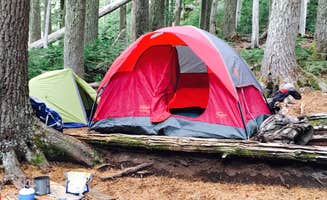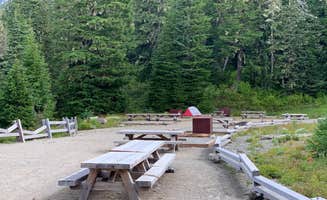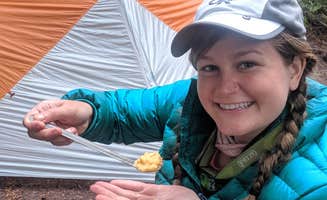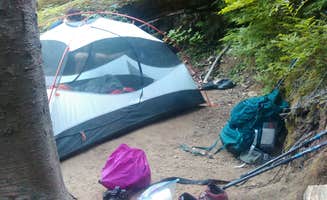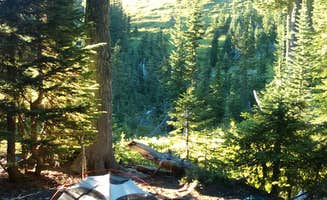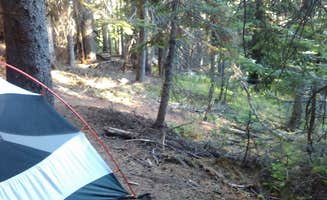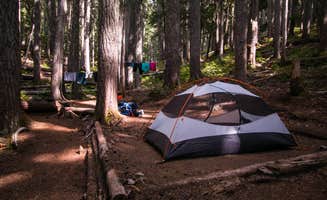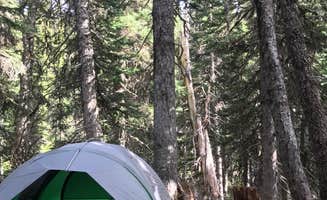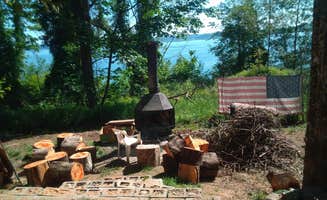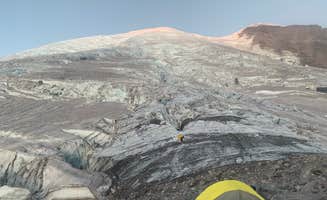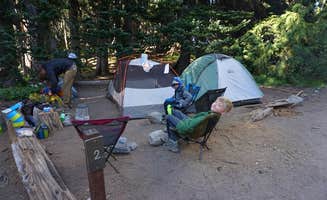Tent camping near Orting, Washington includes numerous wilderness sites beyond those at Mount Rainier National Park. Sites outside the park don't require the national park entry fee and often allow campfires, unlike many Mount Rainier backcountry sites. The topography varies significantly across the region, with riverside camping locations offering easier access than high-elevation mountain sites that can remain partially snow-covered until July.
What to do
Hike from camp to alpine lakes: Mowich Lake Campground serves as an excellent starting point for trails leading to alpine features. "Great trails right from site," explains camper Laura F., who adds that despite the remote location, "you will be all by yourself and there is nothing out there." The trails connect to destinations beyond those mentioned in typical guides.
Cross log bridges to unique camping spots: Carbon River Camp offers a distinct camping experience with interesting access features. "You have to cross a log bridge to access this site, which I have pictured. I love that kind of log bridge, but it can be a little intimidating," notes Danielle S. The area also includes "a really awesome suspension bridge" worth exploring even if you don't cross it during your approach.
Experience riverside camping: White River Dispersed Camping areas provide direct river access without the restrictions of national park sites. "Each site is pretty small...maybe enough for 2-3 tents. Be careful of getting too close to the river because it looks like the earth can erode and break away into the river," warns camper Jada P., highlighting the need for caution near the water's edge.
What campers like
Privacy between sites: Eagles Roost Camp receives praise for its site layout. "The sites are spaced out nicely from each other and there is a real feeling of privacy," writes Danielle S., adding that it's "a short hike from Mowich Lake" and has "good water access" from "an incredible waterfall" near the campground.
Sound of rushing water: Many sites near Orting feature natural white noise from nearby water features. Trevor L. describes Eagles Roost Camp as having "amazing waterfalls" and being "clean" and "covered by a ton of beautiful trees," making it popular among hikers seeking both visual and auditory natural elements.
Camping platforms at some sites: Ipsut Creek Backcountry Campground provides structured camping areas despite its remote location. "The camp itself is pretty large, with plenty of tent sites, tables, and bear boxes. There were also lots of trees for hammock camping if that's your thing," explains Marley B., highlighting the infrastructure available at this walk-in site.
What you should know
Road conditions vary dramatically: Access to many sites requires navigating unpaved forest roads. Laura F. warns about Mowich Lake: "Bit of a rough ride to get up there but totally worth it," adding a practical tip to "get gas before you go up, the town has signs saying last chance for gas."
Bear awareness is essential: Multiple campsites feature bear boxes due to active wildlife. "There are bears! Although I didn't see one apparently according to our neighbor he walked right behind me," reports Laura F. about camping at Mowich Lake, emphasizing the importance of proper food storage.
Temperature fluctuations: Camping near Mount Rainier means preparing for cold nights regardless of season. As camper Kasey notes about White River Dispersed Camping, "Temperatures reached as low as 40F. Fortunately we were prepared, but you may not be." Pack warm layers even for summer camping.
Tips for camping with families
Choose sites with river access: Families particularly enjoy the White River areas where children can safely explore waterways under supervision. "I love the view and the sound of the river! Each site is pretty small...maybe enough for 2-3 tents," mentions Jada P., indicating these sites work well for smaller family groups.
Look for hammock-friendly spots: Kid-friendly camping often means having entertainment options. Kier S. rates NF-52 Dispersed Camping favorably for hammock camping: "One of my favorite dispersed sites of all time... there are lots of sites, and the view of rainier is amazing!" This allows children to have a fun place to relax.
Pack extra bug protection: Multiple reviews mention insect activity, especially at riverside locations. "It was a little buggy and it's not a super special spot to camp but it was a nice stay," notes Simon M. about NF-52 camping, suggesting families should bring adequate repellent and protective clothing.
Tips from RVers
Height clearance considerations: Most primitive camping near Orting works best for vehicles with higher clearance. Rich P. advises about White River Dispersed sites: "4x4/high clearance vehicles recommended - saw some subarus trying to navigate into a cleared area and it was pretty scrape-y." Choose a campground with appropriate access for your vehicle size.
Limited turnaround space: Forest roads often lack adequate space for larger vehicles to turn around. "The road gets a bit worse as you drive further, but it was manageable," reports Reagan S., suggesting RV campers should scout ahead or research thoroughly before committing to narrow forest roads.
Overflow parking limitations: At walk-in campgrounds, parking may be restricted to designated areas. Jessie T. notes about Mowich Lake: "cars have to be parked away from the campsite," which creates logistical challenges for RVers needing to transport gear from vehicle to campsite, especially with larger groups.


